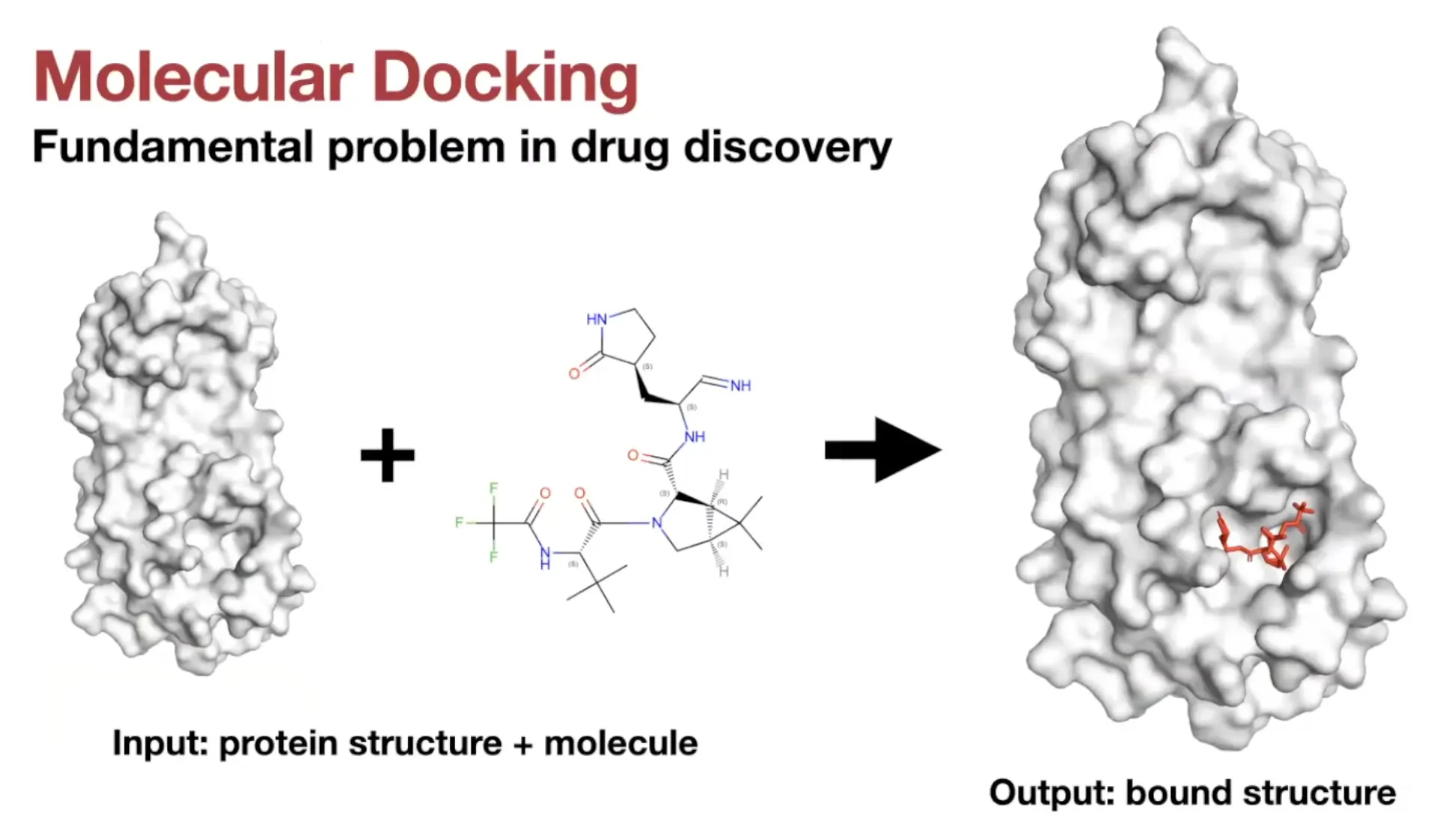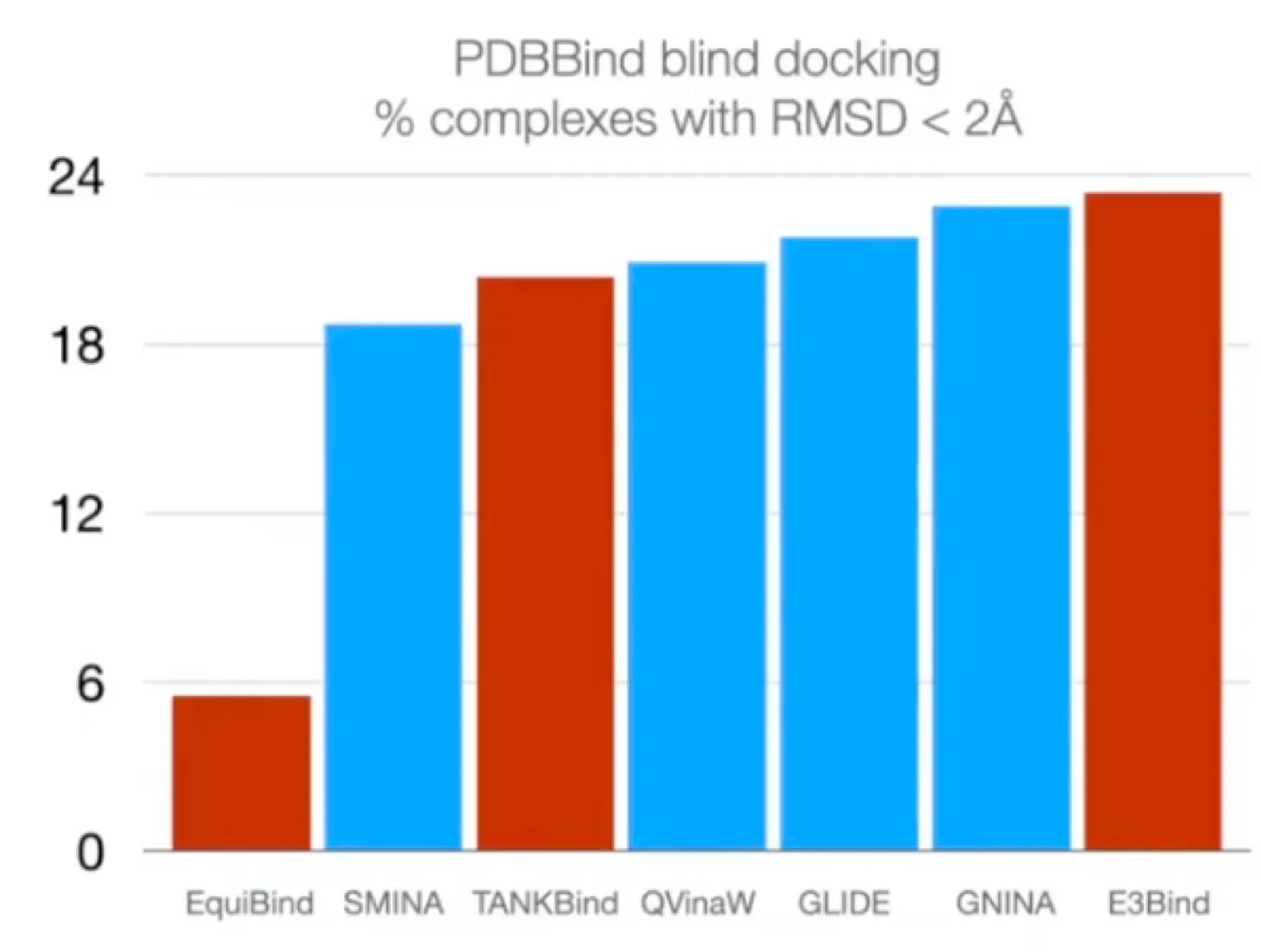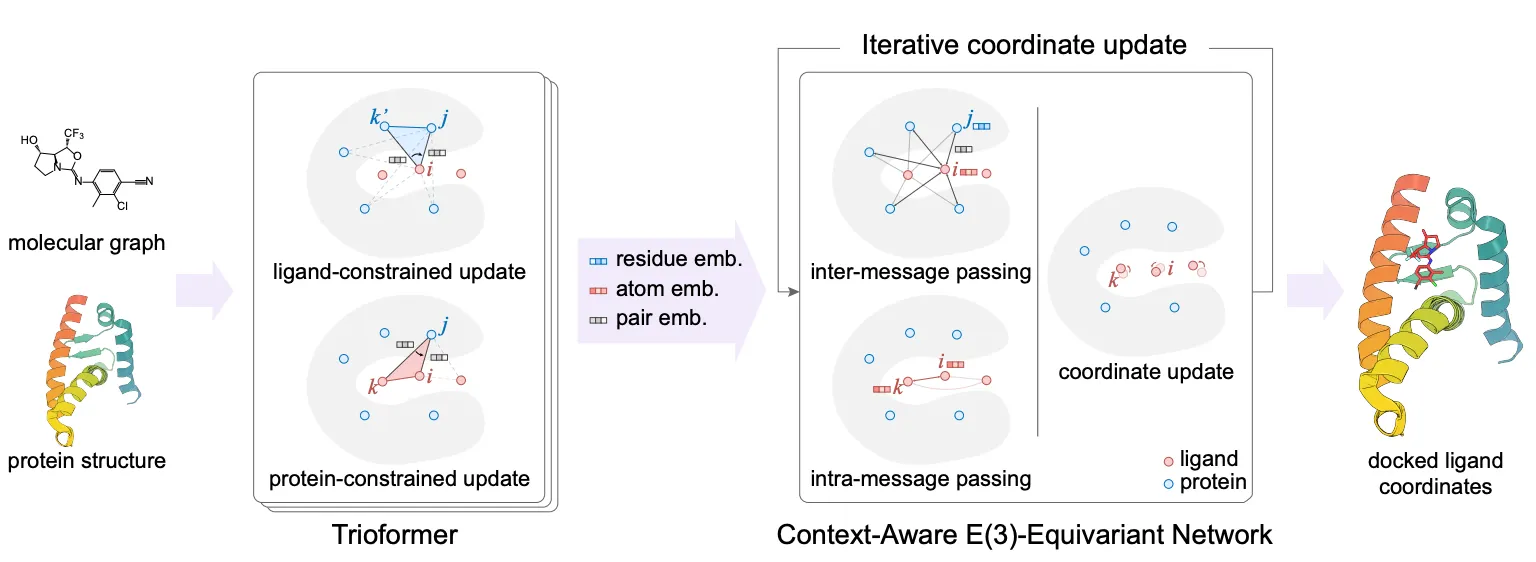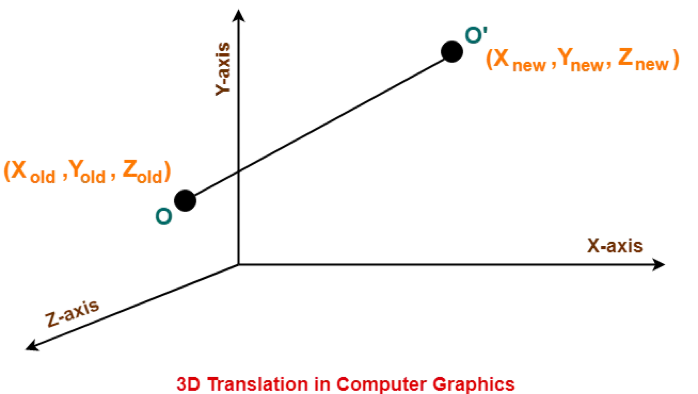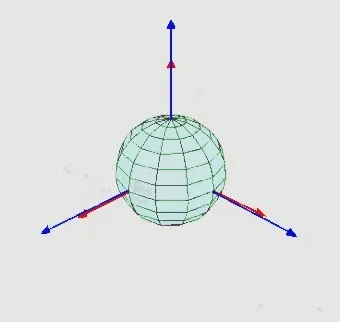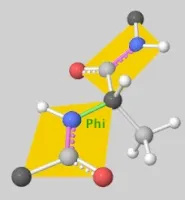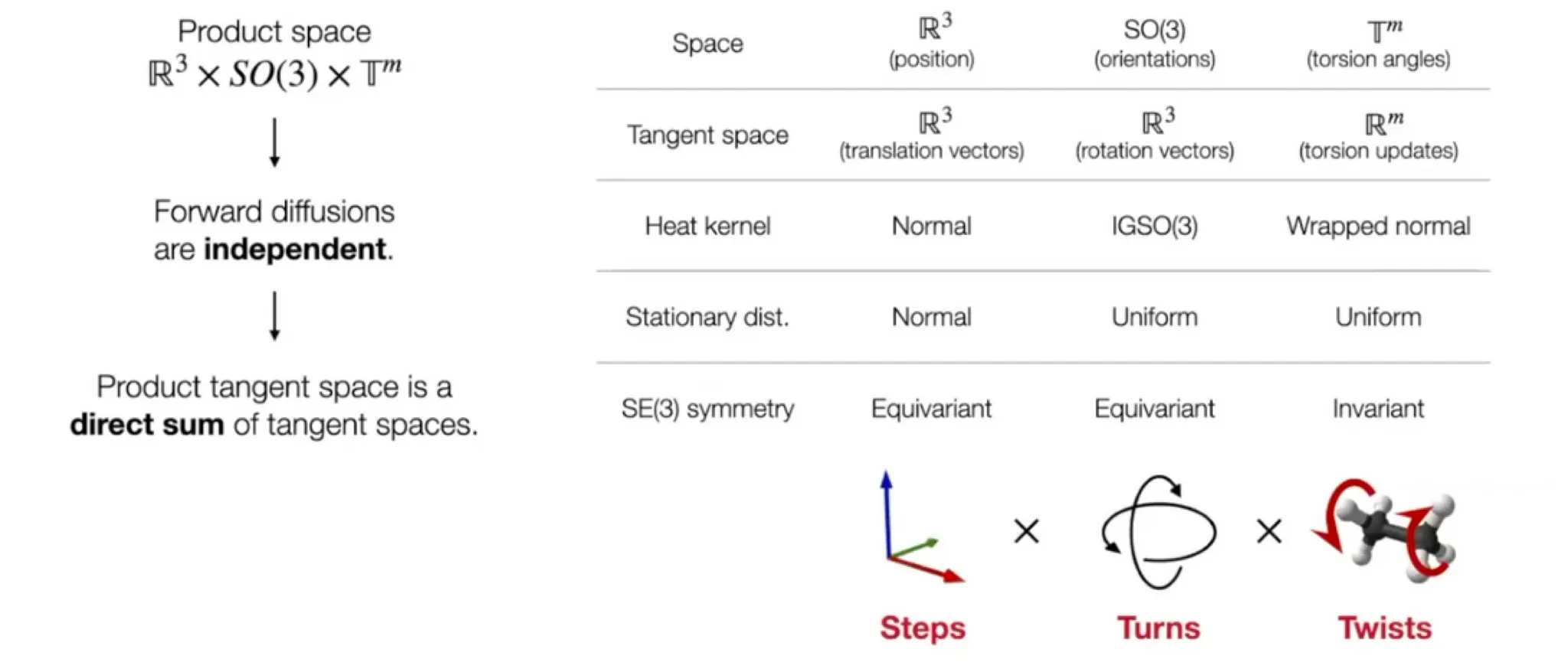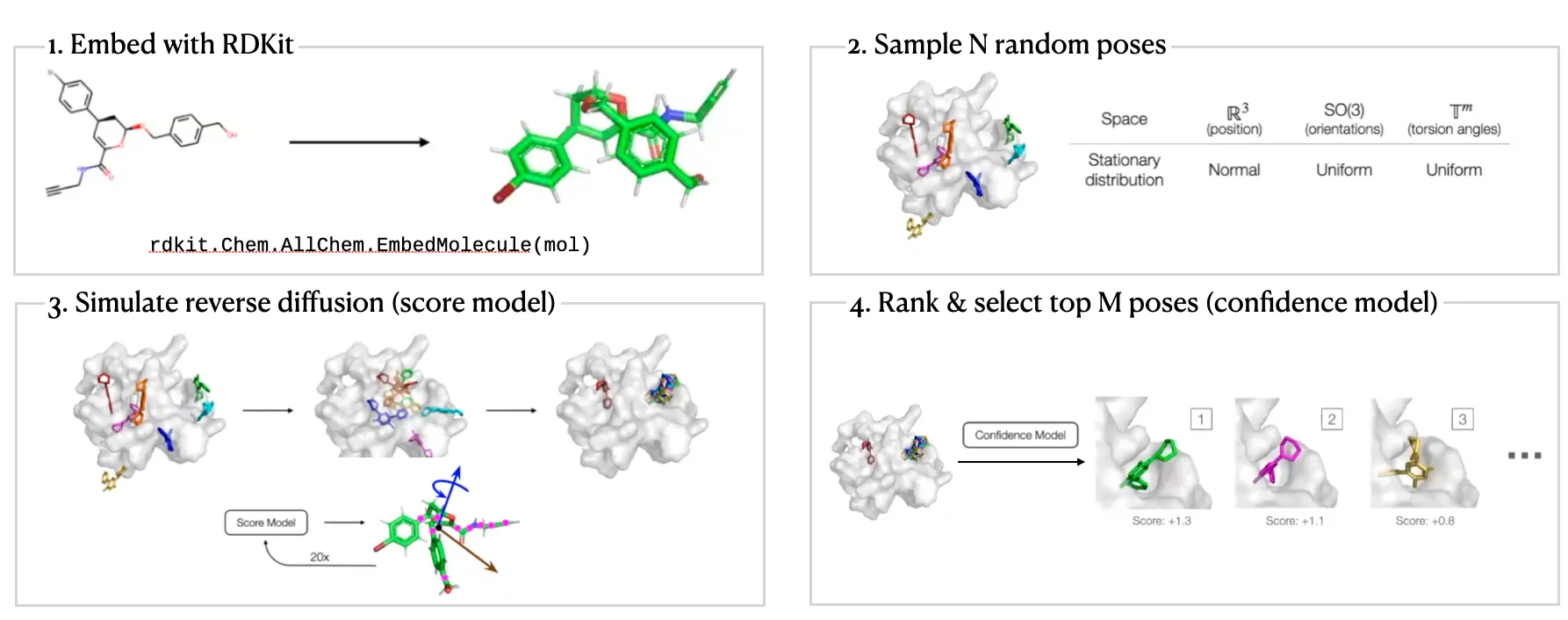Keynote file
Remarks
•
본 논문은 molecular docking을 generative problem으로 간주한 첫 연구이자, 굉장히 흥미로운 결과들을 보여주었고, 성능 향상을 달성했다.
•
Diffusion과 molecular docking에 관심이 있다면 꼭 한 번 읽어봐야 할 논문이다.
•
Summary
•
Molecular docking을 regression이 아닌, generative problem으로 formulation
◦
Target protein 구조 를 조건으로 하여, ligand의 위치와 구조의 distribution을 학습 →
•
Generation에 diffusion process 사용
•
두 개의 구분된 모델 사용
◦
Score model:
Ligand, protein, timestep을 input으로 하여 score를 prediction하는 model
◦
Confidence model:
Ligand와 protein의 구조를 바탕으로 ground truth ligand pose 대비 RMSD 기준 2Å 이하의 pose일 확률 return
•
Diffusion on Product space
◦
Degree of freedom을 에서 로 축소하여 diffusion 수행
Preliminaries
Molecular Docking
•
Definition:
Target protein에 결합한 ligand의 position, orientation, conformation을 예측하는 것을 의미
•
Two types of tasks 크게 두 종류의 task로 구분함
◦
Known-pocket docking
▪
Protein의 binding pocket의 위치 정보를 주고 예측
◦
Blind docking
▪
Binding pocket에 대한 정보 없이 예측하는 더 일반적이고 어려운 상황
Previous works: Search-based / Regression-based
•
Search based docking methods
◦
Traditional methods
◦
Parameterize 된 physics 기반의 scoring function과 search algorithm으로 구성
◦
Scoring function
▪
Input: 3D 구조
▪
Output: 특정 pose에 대한 quality나 likelihood 예측
◦
Search algorithm
▪
Ligand pose (position, orientation, torsion angles)를 확률론적으로 랜덤하게 (stochastically) 바꿈
▪
Goal: scoring function의 global optimum을 찾는 것
◦
Scoring function을 parameterize하기 위해 ML이 적용되고 있지만, search space 가 너무 커서 계산량이 매우 많다.
◦
예시
•
Regression based methods
◦
최신 딥러닝 기반의 방법들이 ground truth position에 대해 regression으로 formulation
◦
Search based method 대비
▪
속도는 상당히 빨라짐.
▪
정확도에 있어서는 부족하거나, 비슷한 정도.
Docking objective
•
Standard evaluation metric:
◦
: 으로 예측한 것들의 비율 → 미분 불가능함.
◦
대신, 을 objective function 으로 사용함.
•
Regression은 unimodal일 경우에만 이 objective function과 일맥 상통함.
•
그러나 Docking은 상당한 aleatoric (irreducible) & epistemic (reducible) uncertainty 지님.
◦
Regression 방법들은 를 최소화하는 것이 목적이고, 이는 여러 mode들의 weighted mean을 예측하도록 학습할 것.
◦
반면 generative model은 대부분의 mode에 대해 generation 가능.
•
실제 결과를 살펴보면, EquiBind 같은 regression model은 여러 mode들의 중간에 위치하도록 예측함.
•
반면 generative model은 여러 mode들에 대해 conformer를 위치시킬 수 있음.
•
DiffDock이 steric clash가 덜하다.
Diffusion Model
DiffDock Overview
•
두 단계 model 사용
◦
Score model: Translation (평행 이동), rotation (회전), torsion (비틀림)에 대해 reverse diffusion 수행
◦
Confidence model: 각 ligand pose가 ground truth 와 비교 시 차이로 잘 위치했는지 binary prediction.
Score model
•
Ligand pose: (: number of atoms)
•
하지만 molecular docking은 이보다 더 적은 degree of freedom으로 수행할 수 있다.
◦
축소된 degree of freedom:
▪
Local structure: RDKit conformer generation (EmbedMolecule(mol)) 이후 어느 정도 고정되어 있다고 가정할 수 있음.
•
Bond length, angle, small rings
▪
Position (translation): - 3D vector
▪
Orientation (rotation): - three Euler angle vector
▪
Torsion angles: (: number of rotatable bonds)
▪
Product space 에서 diffusion 수행 가능
•
Seed conformation 가 주어진 상황이라면, mapping 는 bijection 이다.
Confidence Model
•
Generative model은 여러 pose를 sampling 할 수 있지만, 대부분 연구자들은 1개나 몇 개 정도의 sample만 보기를 원한다.
•
따라서 confidence prediction은 downstream task에 있어 유용하게 사용될 수 있다.
•
Confidence model
◦
: Ligand의 pose
◦
: Target protein의 구조
•
Sample들은 confidence score로 순위가 매겨지고, 가장 좋은 순위의 confidence score가 사용된다.
•
Training & Inference
◦
학습된 diffusion score model에 대해 후보 pose들을 sampling 하고, binary label (각 pose가 ground truth pose 대비 인지 아닌지)을 만든다.
◦
이후 confidence model은 binary label을 맞추도록 cross entropy loss로 학습된다.
◦
Inference 시에는 diffusion score model이 개의 pose를 생성하고, confidence model에 그 pose가 전달되어 confidence score 기반으로 순위를 매겨 사용한다.
DiffDock Workflow
DiffDock Results
Personal opinions
•
Molecular docking을 generation problem으로 formulation 했다는 점이 아주 인상 깊다.
•
Conformer generation의 condition으로 protein structure를 사용했다.
•
하지만 two step approach라는 점, 그리고 confidence model의 input이 predicted ligand pose 와 protein structure 인데, 결국 예측하는 것은 “predicted ligand pose 와 ground truth ligand pose 간의 차이가 2Å 이하인지” 라서 약간의 괴리감이 있는 것 같다.
•
아직 성능 개선의 room 이 상당히 남아있지만, GPU workload가 꽤 많이 들어서 우리 연구실에서 수행하기에는 어려울 수도 있을 것 같다는 생각이 든다.
•
Docking 이지만 physics 기반의 inductive bias가 들어가 있지는 않은 것 같아서 얼마나 generalization 하기에 적합한지 의문이다.
.png&blockId=e42f2256-2168-4a56-bce9-da3889921dbe&width=3600)
